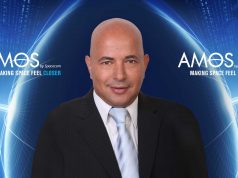We have repeatedly heard that AMOS satellites have the best performance over the territory of Ukraine and provide Ukrainian channels with the best quality of broadcasting. To find out whether this is true and what exactly are the performance indicators that make AMOS so proud, Mediasat turned to Jehuda Amir, AMOS-Spacecom VP Sales in Eastern Europe and CIS.
– You have repeatedly stated that AMOS satellites are the best solution for Ukrainian channels. Is this a marketing statement or do the AMOS-3 and AMOS-7 indeed boast the best performance indicators?
AMOS satellites are indeed the most powerful ones over the territory of Ukraine and provide the best coverage. We cover 100% of satellite households in Ukraine. Moreover, AMOS satellites have a power advantage of at least 2 dB over alternative satellites. Radiation power in the 36 MHz band is 54 dBW while other satellites over the territory of Ukraine in the same 36 MHz band have a power of 51-52 dBW. AMOS satellites support standard frequencies, 14.0-14.5 GHz and 13.75 – 14.5 GHz for AMOS-7 and AMOS-3, respectively, on which the satellite signal is more weather-resistant and standard common equipment which costs the user less.
But the main issue and unique fof our service to the Ukrainian market is that only Spacecom has spare resources in orbit for a possible case of emergency: AMOS-3 and AMOS-7 satellites are located virtually at the same spot and will always be able to back each other up. This is extremely important for providing reliable and continuous TV services.
– Is an occurrence of signal interference or performance degradation when switching from the main satellite to the backup one possible?
The distance between the satellites is so small that its effect on reception quality is negligible. The polarization angle is the same for both satellites. The EIRP level of AMOS-3 and AMOS-7 is approximately identical, which means that the quality of signal reception will not change for the end user.
– Are there any restrictions on the equipment selection to work with AMOS satellites?
None; AMOS satellites operate at standard frequencies and use common technologies, which allows the use of any standard equipment.
– What is the AMOS-Spacecom’s current situation in the global market? Has the crisis caused by the pandemic affected you?
Spacecom is currently expanding its activity in the global market, especially in Africa. A year ago, our new fully digital HTS AMOS-17 was launched, operating in the C, Ku, and Ka bands with a cross-connect possibility. This satellite was designed by Spacecom and built by Boeing using advanced engineering and provides unique opportunities for telecom companies around the world interested in operating in the African market. As an example, we can cite the high-speed high-quality connectivity between Europe and Africa established under a contract with the Czech telecom service provider GiTy. This provider has been our customer on AMOS-3 for many years, and with the advent of AMOS-17, GiTy began providing communications services to embassies in Africa via our new satellite.
We have made all necessary arrangements to guarantee quality of service for our customers. The control center staff works in shifts, with all the necessary precautions, and are ready to respond to our customers’ requests 24/7. During COVID-19 isolation, telecommunications have begun to play an even greater role for both the public and business sectors, and we are ready to respond to growing market demands. The company has set up all the necessary work processes, thus, we do not experience any negative impact on our business. Due to restrictions on air travel we now hardly attend any offline conferences, and personal meetings are limited; however we continue concluding deals and growing our share in the African market.
– What is your opinion on the situation of the satellite market of Ukraine and how do you assess the prospects for its development?
The main goal for TV channels and providers now is to create a full-fledged pay TV market. This can be achieved through using various models and their combinations. Results of research we use show that the share of satellite TV continues to grow slowly but steadily. The role of satellite remains extremely high, and so far, nothing can guarantee the quality of signal transmission better than a satellite, as well as provide reservation, broadcasting of international versions of TV channels, etc. In many regions, it is only satellite that can provide sufficient coverage and access to full TV package and the Internet. I want to note that the equipment for satellite Internet is becoming more accessible, and user solutions, more convenient for viewers.
It is important for the Ukrainian market of satellite services to maintain a balance and prevent monopolization with all the ensuing negative consequences, like when the monopolist may increase rates, dictate terms, etc.
The Ukrainian market is very important for us, and we are proud of the fact that AMOS-1 became one of the first satellites Ukrainian channels started broadcasting from and that we have been part of the Ukrainian market for 23 years and continue participating in its development.












